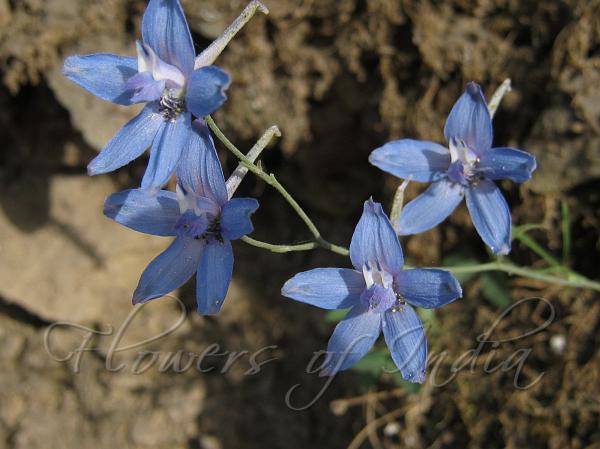|
| Jadwar |
|

|

| File size | 366333 |
| Original date | 4/30/11 4:16 PM |
| Resolution | 2048 x 1536 |
| Flash | Flash did not fire, auto |
| Focal length | 6.6mm |
| Exposure time | 1/800s |
| Aperture | 3.0 |
| Focus Distance | |
| Metering Mode | Multi-segment |
| Camera make | Canon |
| Camera model | Canon PowerShot A495 |
| Sensor type | OneChipColorArea |
|
|
|
|
Photo: |
Botanical name: Delphinium denudatum Family: Ranunculaceae (Buttercup family)
Jadwar is critically endangered Himalayan herb, which was
once commonest species. It is distinguished by its relatively small blue
or violet flowers, borne in a widely branched inflorescence with a few
spike-like clusters. Flowers are about 2.5 cm, with the upper outer petals
about 1.2 cm and a spur 1.4-1.5 cm. Upper inner petals are white, the
others blue. Leaves are 5-15 cm across, rounded in outline, cut into 3-5
broadly obovate segments, segments pinnately cut into oblong lobes or
teeth 2-3 mm wide. Jadwar is found in the Himalayas, from Pakistan to C. Nepal, at altitudes of 1500-2700 m.
Flowering: June-August.
Medicinal uses: It is one of the important drugs used as
indigenous medicine in India, especially in Unani medicine. The roots of
the plant are reported to be useful in a variety of ailments such as
aconite poisoning, brain diseases, fungal infection, piles and toothache
as analgesic and astringent. A number of studies have been done on its
phytochemical and pharmacological properties. Its use in opium addiction
is mentioned in some classical literature, which has been verified and
validated in morphine induced physical dependent de-addiction studies.
It is one of the important drugs used as
indigenous medicine in India, especially in Unani medicine. The roots of
the plant are reported to be useful in a variety of ailments such as
aconite poisoning, brain diseases, fungal infection, piles and toothache
as analgesic and astringent. A number of studies have been done on its
phytochemical and pharmacological properties. Its use in opium addiction
is mentioned in some classical literature, which has been verified and
validated in morphine induced physical dependent de-addiction studies.
Medicinal uses:
 It is one of the important drugs used as
indigenous medicine in India, especially in Unani medicine. The roots of
the plant are reported to be useful in a variety of ailments such as
aconite poisoning, brain diseases, fungal infection, piles and toothache
as analgesic and astringent. A number of studies have been done on its
phytochemical and pharmacological properties. Its use in opium addiction
is mentioned in some classical literature, which has been verified and
validated in morphine induced physical dependent de-addiction studies.
It is one of the important drugs used as
indigenous medicine in India, especially in Unani medicine. The roots of
the plant are reported to be useful in a variety of ailments such as
aconite poisoning, brain diseases, fungal infection, piles and toothache
as analgesic and astringent. A number of studies have been done on its
phytochemical and pharmacological properties. Its use in opium addiction
is mentioned in some classical literature, which has been verified and
validated in morphine induced physical dependent de-addiction studies. | Identification credit: Krishan Lal | Photographed in Himachal Pradesh. |
• Is this flower misidentified? If yes,